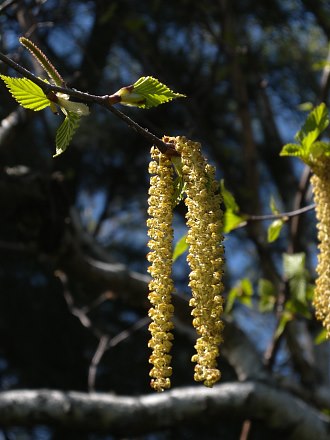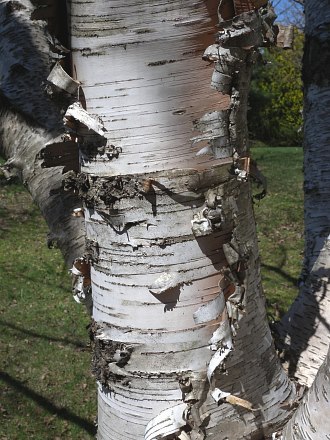 serrate-dentate along
their margins. The
base of each leaf is rounded, truncate, or slightly cordate, while its
tip forms an obtuse point. Each leaf has up to 9 lateral veins on each
side of the central vein; the larger teeth of the margins are located
where the lateral veins terminate. The upper surface of the leaves is
medium green and glabrous, while the lower surface is usually pale
green and glabrous to pubescent. The slender petioles are ½-1" long,
pale green or pale yellow, and glabrous to finely pubescent. Paper
Birch is monoecious, producing both male (staminate) and female
(pistillate) flowers on the same tree; both types of flowers are
organized into catkins. Premature forms of the catkins first develop
during the fall, overwinter in a dormant state, and become mature
during the spring as the leaves develop. Mature male catkins are 2-4"
long, cylindrical in shape, and yellowish; they are usually arranged in
groups of 3 and droop from the twigs near their tips. Each male catkin
has numerous tiny flowers less than 1/8" (3 mm.) across; the male
flowers are
arranged in clusters of 3 behind tiny bracts. Individual male
flowers consist of a tiny 4-lobed calyx and 2 stamens (there are no
petals). Mature female catkins are 1-2" long, narrowly cylindrical in
shape, and greenish; they are ascending, rather than drooping, and
develop individually near the tips of twigs. On each female catkin, the
female flowers are organized into clusters of 2-3 behind tiny
bracts. Individual bracts have 3 upper lobes that are
divergent and they are usually ciliate or
pubescent. Individual female flowers
consist of a naked ovary with a pair of styles; they are less than 1/8"
(3 mm.) across. The flowers are cross-pollinated by the wind during the
spring. Afterwards, the male catkins wither away, while the female
catkins droop downward and become cone-like in appearance from the
hardening of the bracts. The female flowers are replaced by small
nutlets with lateral wings that are membranous and slightly wider
than the nutlet. These winged nutlets are usually dispersed by the wind
during the autumn; they can also be blown across the snow or
transported by water. The root system is shallow and spreading. This
tree spreads by reseeding itself. The deciduous leaves turn yellow
during the autumn.
serrate-dentate along
their margins. The
base of each leaf is rounded, truncate, or slightly cordate, while its
tip forms an obtuse point. Each leaf has up to 9 lateral veins on each
side of the central vein; the larger teeth of the margins are located
where the lateral veins terminate. The upper surface of the leaves is
medium green and glabrous, while the lower surface is usually pale
green and glabrous to pubescent. The slender petioles are ½-1" long,
pale green or pale yellow, and glabrous to finely pubescent. Paper
Birch is monoecious, producing both male (staminate) and female
(pistillate) flowers on the same tree; both types of flowers are
organized into catkins. Premature forms of the catkins first develop
during the fall, overwinter in a dormant state, and become mature
during the spring as the leaves develop. Mature male catkins are 2-4"
long, cylindrical in shape, and yellowish; they are usually arranged in
groups of 3 and droop from the twigs near their tips. Each male catkin
has numerous tiny flowers less than 1/8" (3 mm.) across; the male
flowers are
arranged in clusters of 3 behind tiny bracts. Individual male
flowers consist of a tiny 4-lobed calyx and 2 stamens (there are no
petals). Mature female catkins are 1-2" long, narrowly cylindrical in
shape, and greenish; they are ascending, rather than drooping, and
develop individually near the tips of twigs. On each female catkin, the
female flowers are organized into clusters of 2-3 behind tiny
bracts. Individual bracts have 3 upper lobes that are
divergent and they are usually ciliate or
pubescent. Individual female flowers
consist of a naked ovary with a pair of styles; they are less than 1/8"
(3 mm.) across. The flowers are cross-pollinated by the wind during the
spring. Afterwards, the male catkins wither away, while the female
catkins droop downward and become cone-like in appearance from the
hardening of the bracts. The female flowers are replaced by small
nutlets with lateral wings that are membranous and slightly wider
than the nutlet. These winged nutlets are usually dispersed by the wind
during the autumn; they can also be blown across the snow or
transported by water. The root system is shallow and spreading. This
tree spreads by reseeding itself. The deciduous leaves turn yellow
during the autumn.Cultivation: The preference is full or partial sun, moist to dry-mesic conditions, cool summer temperatures, and soil consisting of sandy or silty loam. This tree also adapts to upland areas with rocky soil, but its growth is stunted. Longevity of individual trees is 150 years or less. Outside of boreal areas with a cool climate, this tree tends to be short-lived.

Range & Habitat: Paper Birch is an uncommon native tree that is found in northern Illinois (see Distribution Map). It is more common further to the north. Habitats include upland woodlands and savannas (often sandy or rocky), open disturbed woodlands, stabilized sand dunes near Lake Michigan, and riverbanks. Paper Birch is cultivated as an ornamental landscape tree. Paper Birch is a pioneer species that responds positively to disturbance, especially wildfires that damage dominant canopy trees.
Faunal Associations: The number of insects that feed on Paper Birch and other birches (Betula spp.) is quite extensive. The caterpillars of the butterflies Nymphalis antiopa (Mourning Cloak), Nymphalis vau-album j-album (Compton Tortoiseshell), and Polygonia faunus (Green Comma) feed on birches, as do the caterpillars of numerous moths. Other insect feeders include the larvae of Croesus latitarsis (Dusky Birch Sawfly) and other sawflies, the larvae of Agrilus anxius (Bronze Birch Borer) and other wood-boring beetles, Polydrusus impressifrons (Pale Green Weevil) and other weevils, Altica betulae and other leaf beetles, Kleidocerys resedae (Birch Catkin Bug), the leaf-footed bugs Elasmucha lateralis and Elasmostethus interstinctus, Calaphis betulaecolens
 (Common Birch Aphid) and
other aphids, and the leafhopper
Erythridula praecisa
(syn. Erythroneura
praecisa). The aphid Calaphis leonardi is reportedly monophagous on Paper Birch. The Insect Table
shows a more complete listing of these insect species. Paper Birch
and other
birches are used by vertebrate animals as a source of food, nesting or
den habitat, and cover. The following birds eat the seeds of these
trees: the Wood Duck, Green-winged Teal, Blue Jay, Dark-eyed Junco,
Pine Siskin, American Goldfinch, Tufted Titmouse, Black-capped
Chickadee, Wild Turkey, and Ring-necked Pheasant. The Ruffed Grouse
eats the buds and/or
catkins, while the Yellow-Bellied Sapsucker drills holes into the thin
bark of Paper Birch to suck the sap (DeGraaf, 2002). Various mammals
also rely on Paper Birch
and other birches to some extent as a source of food: the Red Squirrel
and American Black Bear
eats the seeds, the American Beaver gnaws on the wood, while the
Cottontail
Rabbit and White-Tailed Deer browse on the twigs and foliage,
especially of seedlings and saplings (Martin et al., 1951/1961; Romain
et al., 2013).
(Common Birch Aphid) and
other aphids, and the leafhopper
Erythridula praecisa
(syn. Erythroneura
praecisa). The aphid Calaphis leonardi is reportedly monophagous on Paper Birch. The Insect Table
shows a more complete listing of these insect species. Paper Birch
and other
birches are used by vertebrate animals as a source of food, nesting or
den habitat, and cover. The following birds eat the seeds of these
trees: the Wood Duck, Green-winged Teal, Blue Jay, Dark-eyed Junco,
Pine Siskin, American Goldfinch, Tufted Titmouse, Black-capped
Chickadee, Wild Turkey, and Ring-necked Pheasant. The Ruffed Grouse
eats the buds and/or
catkins, while the Yellow-Bellied Sapsucker drills holes into the thin
bark of Paper Birch to suck the sap (DeGraaf, 2002). Various mammals
also rely on Paper Birch
and other birches to some extent as a source of food: the Red Squirrel
and American Black Bear
eats the seeds, the American Beaver gnaws on the wood, while the
Cottontail
Rabbit and White-Tailed Deer browse on the twigs and foliage,
especially of seedlings and saplings (Martin et al., 1951/1961; Romain
et al., 2013).Photographic Location: The Arboretum of the University of Illinois in Urbana, Illinois.
Comments: Paper Birch is widely regarded as an attractive tree, largely because of its white bark that often peels away into strips. While it may be tempting to pull on these bark strips and collect them as souvenirs, this impulse should be resisted as it damages the tree, causing ugly black scars to develop. Paper Birch has an unusually broad range across Canada and northern United States, which extends into the Appalachian mountains. Across this range, several varieties have been described that are not currently recognized in Illinois. Paper Birch is not the only birch species with attractive white bark. Two European species, Betula pendula (Weeping White Birch) and Betula pubescens (White Birch), are often cultivated as landscape trees in the United States and Canada. These species have white bark that is similar to Paper Birch, but their leaves are smaller in size (1½-2½" in length). A North American species, Betula populifolia (Gray Birch), also has whitish bark, but its leaves are more deltate in shape with long tapering tips.